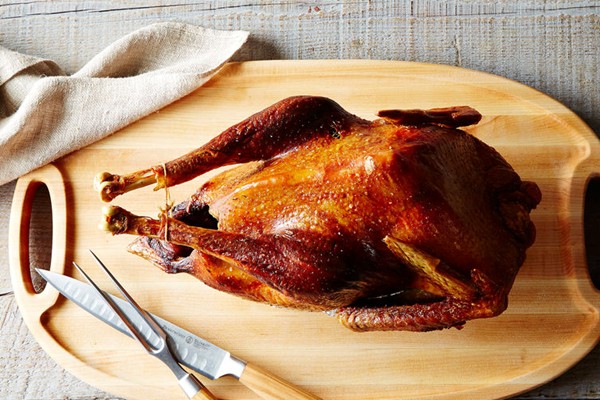Turkey brining has lost its luster
November 12, 2018 by DarcieLike many home cooks, for years I performed a Thanksgiving ritual every November. I would scrub out an oversized bucket, (often a pickle bucket that I pleaded for at a fast food restaurant), fill it with a brine that always took longer to make than I remembered, and plunge an ungainly turkey into it, trying not to slosh salt water everywhere. Then I faced another obstacle – how could I make enough room in the refrigerator to store this gigantic bucket of wet turkey? The fridge looked like a food version of Tetris as I carefully balanced items on top of each other to squeeze the bucket inside.

Taking said turkey out of the bucket was another experience in unwieldy maneuvering. After giving the bird a shower, I and most every horizontal surface within five feet was wet. Eventually the turkey got dried off and into the oven and everything was scrubbed clean, but it was a lot of work. All of this effort was geared toward achieving turkey nirvana: a gorgeous golden bird that had flavorful, juicy meat. And for the most part, brining – touted by television chefs and food writers alike – helped achieve that goal. Fast forward about 15 years, and wet brining is falling out of favor, even among chefs who previously embraced the method. Daniel Krieger, writing for The New York Times, explains why.
The logistical drawbacks to brining, as illustrated above, are one reason. Another is that all of that water, while keeping the bird moist, has a tendency to change the texture of the meat in an unpleasant manner. J. Kenji López-Alt was among the first to criticize the method, writing a column for Serious Eats and elaborating on it in his book The Food Lab. His conclusion was that brining resulted in the a texture that resembled processed luncheon meat.
As wet brining reached its apex in the mid-2000s, a simpler yet equally as effective method was on the rise. Called dry-brining, the method kept the salt, but resulted in a more flavorful, less waterlogged turkey. It was first promoted by Russ Parsons, who wrote about “the Judy bird” in 2006. Since then, others have jumped on the dry brining bandwagon. It’s much easier to do, and you can even salt a frozen turkey as it thaws, a boone for those who don’t want to fuss with a turkey for several days before it’s cooked.
Others are foregoing the brining altogether and using new methods to cook the turkey, such as smoking or deep frying. A few are even taking the turkey off of their Thanksgiving menu completely, turning to other proteins. Still, whether just for sentimental reasons or out of a love of turkey sandwiches, millions of us will be roasting the big bird next Thursday, although fewer of us will be struggling with a wet brine.
Photo of Dry-brined turkey (a.k.a.the Judy bird) [Russ Parsons] from Food52 Genius Recipes
Categories
- All Posts (6941)
- Antipasto (2135)
- Author Articles (247)
- Book News (935)
- Cookbook Giveaways (983)
- Cookbook Lovers (257)
- Cooking Tips (110)
- Culinary News (299)
- Food Biz People (552)
- Food Online (791)
- Holidays & Celebrations (272)
- New Cookbooks (149)
- Recipes (1500)
- Shelf Life With Susie (231)
- What's New on EYB (133)
Archives
Latest Comments
- ebalk02 on Danube Cookbook Review and Giveaway
- ccav on Food news antipasto
- ccav on What foods do you look forward to the most for each season?
- ccav on Danube Cookbook Review and Giveaway
- hibeez on How cookbooks can help build resilience
- Pamsy on What foods do you look forward to the most for each season?
- Pamsy on How cookbooks can help build resilience
- DarcyVaughn on Danube Cookbook Review and Giveaway
- hettar7 on JoyFull – Cookbook Review & Giveaway
- eliza on What foods do you look forward to the most for each season?